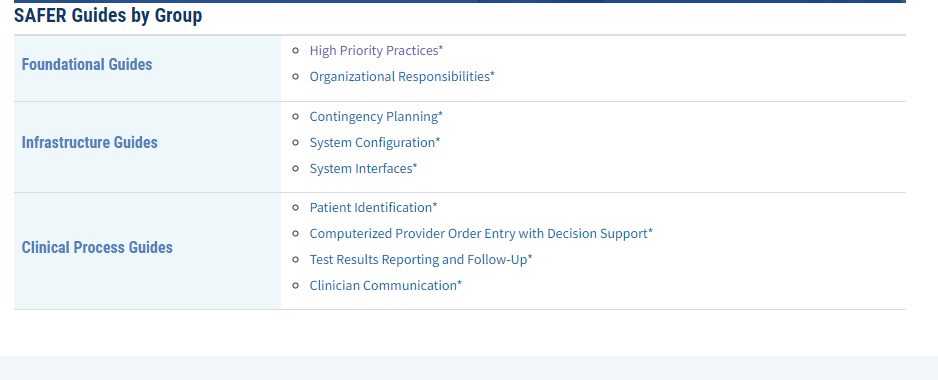SAFER Guides Self-Assessment

SAFER Guides Self-Assessment
SAFER Guides Self-Assessment
The Safety Assurance Factors for EHR Resilience Guides (SAFER Guides) were initially released in 2014 and updated in 2016. Experts designed them to help health systems conduct a proactive risk assessment of electronic health records (EHR) safety-related policies, processes, procedures, and configurations. Healthcare organizations of all sizes can use the SAFER Guides, which consist of nine guides organized into three groups.

In 2022 CMS made the annual SAFER Guides Self-Assessment a requirement for the Promoting Interoperability category of MIPS (Merit-Based Incentive Payment System). The SAFER Guides help organizations prioritize EHR security concerns by identifying “high-risk” and “high-priority” recommended safety practices. The Self-Assessment is an 18-question checklist that also includes team worksheets. The document broadly addresses the EHR safety concerns discussed in greater detail throughout the other 8 SAFER Guides.
To satisfy the MIPS requirement. The MIPS-eligible clinician must attest YES or NO to conducting an annual Self-Assessment of the High-Priority Practices Guide of the SAFER Guides. You can find the Self-Assessment at:
https://www.healthit.gov/topic/safety/safer-guides
The Self-Assessment checklist is divided into 3 separate domains:
Domain1 – Safe Health IT
Domain 2 – Using Health IT Safely
Domain 3 – Monitoring Safety
A multidisciplinary team should complete the Self-Assessment for the organization. The assessment requires the engagement of people inside and outside the organization. CMS will not score your assessment. However, for now, CMS wants to track which organizations are utilizing the Self-Assessment. It is important to note that the EHR Resilience Guides (SAFER GUIDES) Self-Assessment does not replace your yearly Security Risk Assessment.
Disclaimer:
The content provided by TriumpHealth is for informational purposes only and does not constitute legal, medical, or financial advice. Regulations and payer requirements may change; please consult a qualified professional for guidance specific to your situation. Click here to review our full legal disclaimer.
Recent Posts
- MIPS 2026 Updates: A Practical Guide for Clinicians, Practices, and Office Managers
- CHAP Accreditation Updates for DME Suppliers: Step-by-Step Guide for Location Changes and Adding New DME Supplies
- Payer Contract Negotiations: Key Terms & Strategies | TriumpHealth
- Medicare Billing Guidelines for Q-Codes with CPT 15271–15278: A Guide for Wound Care Physicians
- Why Taxonomy Codes Matter in Provider Credentialing & Medical Billing
- How to Transition Provider Credentialing When Leaving or Joining an ACO
